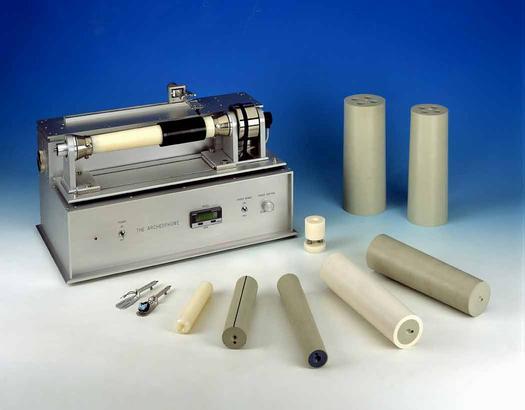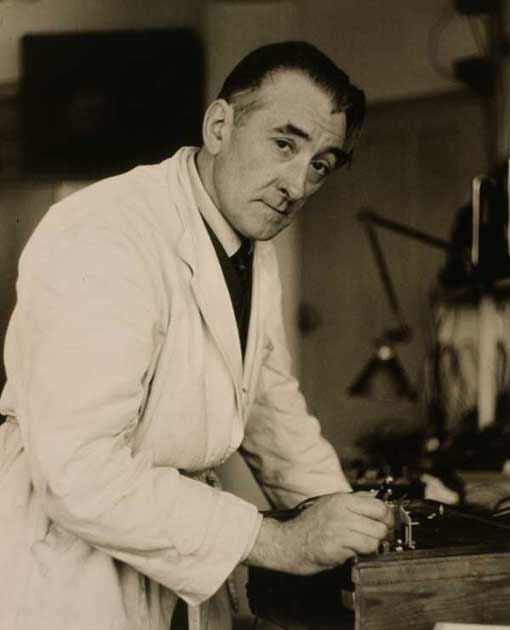Using an antique phonograph to play back sounds recorded on cylinders can cause irreversible damage to them, as they were originally intended to withstand only a limited number of playbacks. Today, it is essential to use appropriate equipment to preserve the recorded contents.
 The Archeophone, a universal phonograph cylinder player, with its main accessories.
The Archeophone, a universal phonograph cylinder player, with its main accessories.
The Archeophone is the chosen technical solution by the following institutions:
University of California, Santa Barbara;
Syracuse University, New York;
University of North Carolina at Chapel Hill;
National Library of Ottawa, Canada;
Edison National Historical Site, New Jersey;
Bibliothèque nationale de France;
Canadian Museum of Civilization, Hull, Canada;
Library of Congress, Washington D.C., United States;
Nationalbiblioteket, Aarhus, Denmark;
Nauck's Vintage records, Spring, Texas;
Phonogalerie, Paris;
Nasjonalbiblioteket, Mo i Rana, Norway;
Discoteca di Stato - Museo dell'Audiovisivo, Roma, Italy;
National Film and Sound Archive, Canberra, Australia;
Rodgers & Hammerstein Archives of Recorded Sound, New York Public Library for the Performing Arts, New York City;
Hochschule Düsseldorf;
NARSSA - National Archives and Records Service of South Africa;
Néprajzi Múzeum, Budapest, Hungary; ...
The following text is excerpted from the Journal of the Museum of Arts and Crafts, Issue No. 27, June 1999.
Adapted and enriched version in 2003.
The Belle Époque produced millions of sound recordings in the form of wax phonograph cylinders. The United States, where
the phonographic industry originated, produced the largest quantity. Several industrialized countries in Europe, including
Germany and Belgium, also manufactured a significant number. In France, the Pathé factory alone produced between 30 to 45
million cylinders from 1900 to 1910. Despite this massive production, only a tiny fraction remains today. This is because
cylinders are very brittle and subject to various types of degradation typical of organic materials and composite materials.
In France, only a few thousand usable documents remain today.
This situation necessitates the essential preservation of these historic sound documents. This preservation effort focuses
on at least three critical points: collection, conservation, and accurate copying.
For collection, many public institutions have preserved a large number of documents until now. Many private enthusiasts
have also found such cylinders, which may someday be accessible. However, there remains a need to identify numerous small
collections existing in museums and libraries across provinces. Many significant sound recordings are sought based on written
records that trace their existence. Examples include private cylinders of Auguste Rodin, a sound report made in Egypt by music
publisher Achille Lemoine, recordings made at the Academy of Fine Arts by Charles Gounod and astronomer Janssen in 1889, and
cylinders from Auguste Baron's Graphophonoscope.
Much work remains in the field of conservation because it is often difficult to distinguish between types of degradation,
whether caused by molds or by instability of components (loss of material homogeneity, with "resurgences" of chemicals
affecting the groove surface, resembling molds). Furthermore, the exact causes of cylinder degradation are still not fully
understood, although it is acknowledged that a fairly low humidity level and stable temperature are the best conservation
conditions.
The work presented here aims to address the third and perhaps most crucial element of this preservation policy: copying the
audio content of ancient cylinders onto modern, digital, or analog media while it is still possible. The copying process poses
similar challenges, though less critical, for early-century records, which tend to preserve better and have many practical
turntables available.
A spontaneous reaction might suggest that playing the cylinder on the original period apparatus would suffice for faithful
reproduction, thereby recreating the listening conditions of the time. However, this idea is illusory for several reasons.
Firstly, recording a sound emanating from a horn for preservation purposes poses significant sound capture challenges. The
resulting recording inevitably includes reverberation effects picked up by the microphone, which somewhat obscure the original
sound message—an echo that the human ear can filter out during direct listening but cannot filter from a recorded sequence.
Additionally, the microphone records the mechanical noise of the phonograph itself, which, while adding to the charm and
sense of authenticity, also affects the sound message. Moreover, when available, period devices, far from being precision
instruments, add wow and flutter—defects that need to be minimized.
Finally, and most importantly, the phonograph, with its heavy sound-producing diaphragm, whether carried by a playback arm
or directly attached to the horn, irreversibly alters the groove with each playback, rendering some cylinders inaudible
after as few as fifty playbacks, even if handled with utmost care. In this regard, it can be asserted that the worst enemy
of the cylinder (and similarly for the disc) is the phonograph itself. Upon first playback on a period apparatus, the
cylinder material is inevitably plowed away in microscopic chips adhering to the diaphragm's dull point.
Some phonograph arms exert a force equivalent to 100 grams concentrated on both groove flanks during playback. Conversely,
optimal playback requires a much lower tracking force to minimize friction and document wear. Therefore, the solution to
cylinder transcription does not lie in using period apparatuses, which nonetheless remain valuable subjects of study from
an acoustic standpoint. Avoiding microphone sound capture, the solution lies in direct electrical playback—a method that
transforms groove modulation into an amplifiable electrical signal.
In the laser era, the most logical solution would be non-contact groove playback using a reflected light beam at the groove's
bottom. This idea faces numerous challenges beyond financial means. Cylinder materials make their grooves poor light
reflectors. Considering the infinite colors and compositions of cylinders, along with several groove widths, an extremely
precise light beam with great flexibility in adjustments would be required to adapt to all refraction indices. Add to this
the fact that many cylinders are not perfectly round, often ovalized or distorted, presenting challenging tolerances for
normal playback, possibly insurmountable for servo-optical playback.
Conditions for good playback:
The major technical problem is the heterogeneity of models. Some cylinders are an inch in diameter (25.4 mm), while others
are over 12 cm in diameter. Lengths vary from 2 to 28 cm! The groove pitch also varies widely. Some cylinders have only 7
spirals per cm, while others have over 20 spirals. Furthermore, all are more or less deformed. These points raise three types
of playback problems: tracking, speed range, and groove adherence consistency.
Track Following:
Most vintage devices, in addition to cylinder rotation, provide lateral movement of the playback system along the cylinder
via a lead screw. Sometimes it is the opposite: the cylinder rotates and moves slowly under a fixed playback system.
In both cases, the lead screw that moves an element is of the same pitch as the cylinder to be read, or at least it is
operated at a speed that allows optimal lateral movement. Hence the problem of compatibility between cylinders becomes
apparent. The most well-known case is that of the two formats of Edison grooves. In the so-called "standard" dimension
(diameter 55 mm, length 100 mm), there are cylinders lasting two minutes. Other "standard" cylinders have a pitch twice
as fine and last, at the same rotation speed, four minutes. Some late Edison players are equipped with a clutch that allows
the same carriage lead screw to be slowed down in a 2-to-1 ratio to read both types of cylinders, with two interchangeable
playback heads, each fitted with the appropriate stylus.
The Archeophone is equipped with an electronic device that controls the arm deviation and automatically adjusts its lateral
movement to match the groove. This servo-controlled deviation is provided by a moving shutter between a light source and two
photoelectric cells, which control the motor that drives the arm. This principle was invented in 1968 by Pierre Clément.
Pierre Clément initially specialized in the construction of electric cutting heads. He is best known as the creator of
numerous models of turntables or "platters". He was long the main supplier to the ORTF in this field.
Clément's optical servo, first incorporated into his legendary A1 and A1B models, has been adopted in almost all
tangential tonearm turntables built since. This system allows cylinders to be played with very low tracking force,
typically between 1 and 3 grams in practice.
Track holding and speed range:
These two parameters are closely related, as they challenge the inertia of the playback arm, which must overcome the following paradox: to track without slipping a microscopic modulation at the bottom of a groove that has a wobble of several millimeters, at a high rotation speed (from 90 to 190 revolutions per minute), with the lowest possible tracking force.
Indeed, the material of a cylinder, whether it is wax or celluloid, is often deformed, causing eccentricity and thus wobble during rotation. The cylinder does not rotate evenly, causing wow during playback and tracking errors. In other words, the arm jumps over the bumps. Eccentric adjusters placed on either side of the cylinder's axis of rotation should allow adjustment of its reading surface to make it consistent and thus reduce wow. Furthermore, a practical solution to ensure tracking of the most deformed cylinders, and therefore reduce the inertia forces that could cause the arm to slip, is to halve the playback speed and record the document onto magnetic tape, which will then be played back at twice the speed.
The Archeophone, considering such requirements, meets all the conditions for good playback and thus enables a rational transcription of the sound content onto modern media. The motor driving the cylinder via a belt can rotate at speeds ranging from 40 to 250 revolutions, and a digital tachometer displays the exact rotation speed.
 L'Archeophone, lecteur universel de cylindres phonographiques, dans sa première version en 1998
L'Archeophone, lecteur universel de cylindres phonographiques, dans sa première version en 1998


